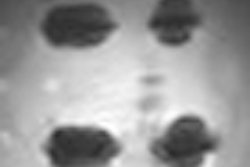A new study in the March issue of Radiology touts CT as an efficient, effective way to analyze wounds from bullets and explosive devices. The wars in Iraq and Afghanistan mean that U.S. troops face threats from increased sniper activity and the use of improvised explosive devices, according to the study.
Current clinical reports of wounds from bullets and bomb fragments do not include the progression of the trajectory or the direction of the wound path, despite the fact that ballistic injuries are not necessarily confined to a single anatomic structure. Although CT has been shown to have value in analyzing wound paths, there is no widely accepted method for consistently and accurately pinpointing wound paths and determining the trajectory angles (Radiology, March 2011).
"The information provided by MDCT has the potential to improve patient care and aid in both military and civilian forensic investigations," said the study's lead author, Les Folio, DO, from the Uniformed Services University in Bethesda, MD, in a statement accompanying release of the study.
For the study, researchers evaluated the accuracy of MDCT-based ballistic wound path identification. A marksman fired six shots from a rifle into two simulated legs made from synthetic materials crafted to represent real tissue.
The legs were tilted at six different angles based on various sniper heights and distances and scanned using 64-detector-row CT (LightSpeed VCT, GE Healthcare, Chalfont St. Giles, U.K.). The helical images were acquired at 2.5-mm intervals reconstructed at 0.625- and 5.0-mm intervals. Several radiologists working independently reviewed the CT images and recorded entrance and exit sites for the bullet trajectories.
The results showed that the angles on CT corresponded closely with those calculated from coordinates with actual shooting angles, and the radiologists were able to identify all six wound paths on the CT images. The tool measured and coordinated calculated angles within 5° of the shooting angles for every shot.
The authors said that the tool's effectiveness means that radiologists can accurately estimate the location of a sniper or an explosive device by extrapolating trajectories identified on MDCT when other factors, such as sniper distance and the victim's position, are known.
Additional research into MDCT's potential to analyze trajectories and wound paths in other areas of the body, including the head, chest, and abdomen, is ongoing inasmuch as phantom legs may not represent the optimal target. Folio is currently leading a study on automated trajectory analysis in Vietnam veterans with traumatic brain injuries.
By Eric Barnes
AuntMinnie.com staff writer
January 11, 2011
Related Reading
CTA assesses traumatic neurovascular injury, October 16, 2007
3D penetrates trauma imaging niche, August 24, 2006
CT mostly outperforms alternatives in penetrating trauma, February 20, 2006
CT is the blanket modality for neuroimaging blunt injury patients, January 12, 2006
When x-ray finds cervical spine injuries, CT picks up more, September 14, 2005
Copyright © 2011 AuntMinnie.com




















